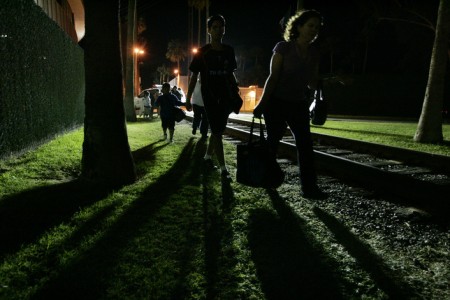

I’m grateful I had the opportunity to see Lynne Sachs’s Your Day Is My Night and hear her speak about it afterward. Her hybrid documentary had me constantly thinking back on my observations and experiences as a young kid spending my summers in the border town of Calexico, Ca. My grandpa owned a ranch one hundred feet away from the U.S./Mexican border crossing and I can recall him housing immigrants on a daily basis. From what I remember, he would house them in a shed that was an extension to his house that consisted of a five-inch thick mattress, a few pillows, toilet paper, food and jugs of water. A single person or family would not stay for more than twenty-four hours as they waited anxiously for their ride. On several occasions, the men usually, would sit in the front porch with my grandpa and would exchange stories from back home. It’s fascinating how a shift-bed and/or a temporary living space can be a catalyst to storytelling. There’s an interesting dynamic that occurs with immigrants and the dialogue coming out when being placed in a shift-bed. It seems that in order to make themselves feel comfortable and create an intimate living space for themselves and within each other, an organic dialogue about home and their personal lives begins. It almost seems unnatural for an immigrant occupying a small space for a short amount of time to not engage on a personal level about themselves to others. As in some of the articles states, the small room, specifically the bed, becomes the stage where this expository dialogue begins about past experiences- both good and bad. In the DNAinfo New York article, Sachs points out a great observation about the benefits of renting out a shift -bed for $150 a month in terms of saving up money. The majority of immigrants work to send money back home. And, in order to make the most money to send, besides working, is to reduce your living cost. As we all make sacrifices, these immigrants are making wise decisions of occupying a small space in order to save the most amount of money for a better future either in the U.S. or back home.
Her documentary had me thinking a lot about my final project for Experimental Production. Currently, I’m living in a single dormitory at Cowell College and I became fascinated about living in a room that has been occupied by at least forty other people in the last forty-five years of the existence of this building (oldest college on campus). I kept thinking about all the men and women that have slept in this room, bed, mattress, stepped on the same carpet, occupied the same closet, looked out the same window and all the different posters/pictures/decorations that have been put up on these walls. My project focuses on my personal living space for nine months and how I’ve chosen to decorate and inhabit my living space. I’m hoping I can translate my personality, anxiety, OCD and personal living conditions within this medium. In a way, I want to document and represent who I am while occupying a temporary dormitory. Keeping in mind that this is not my real home, yet, a temporary living space that will be inhabited by someone else, in a matter of a few months.
Alexis Duran
Film Student, University of California Santa Cruz
